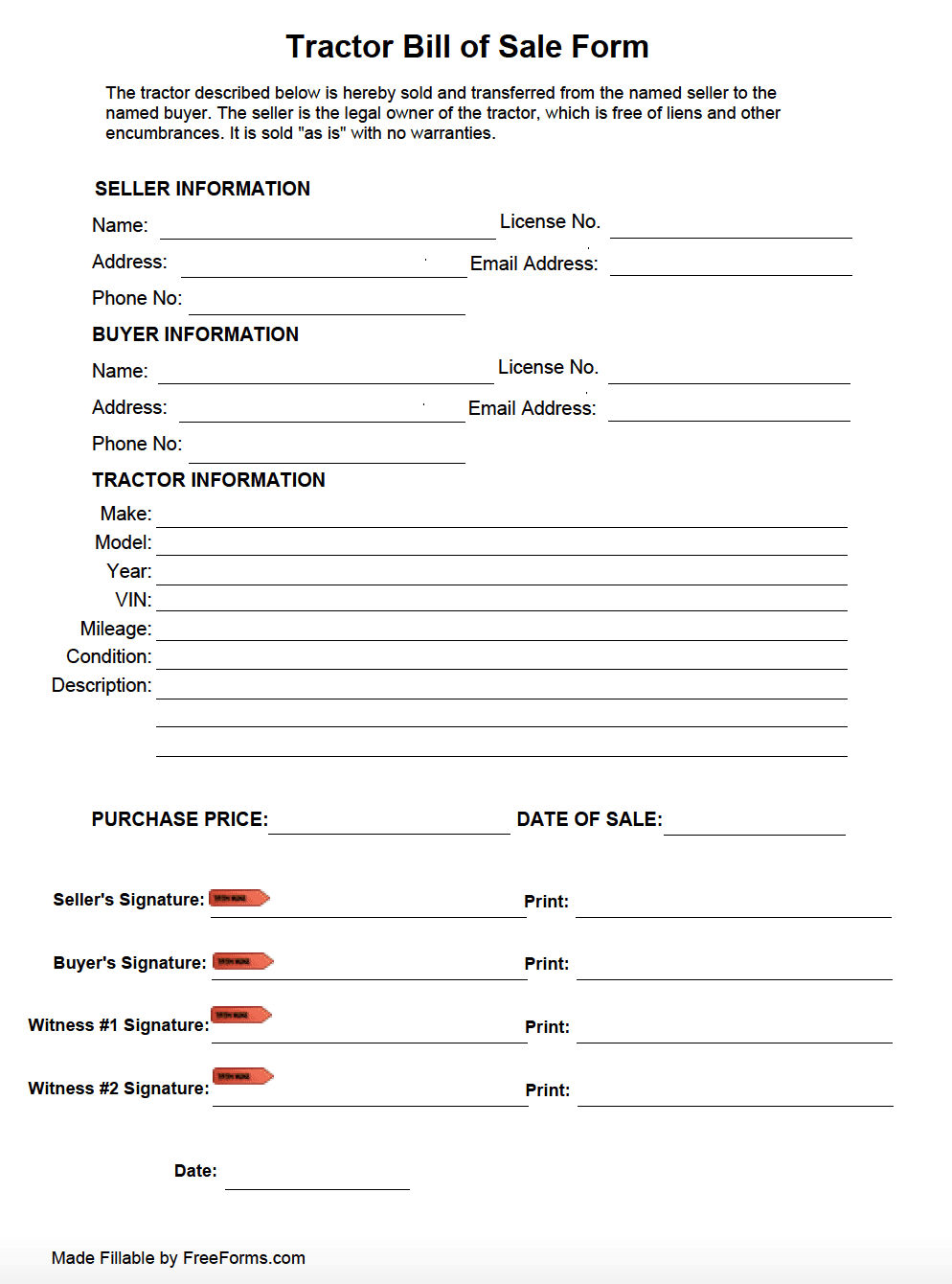A Tractor bill of sale form is a paper document providing information on the sale of a tractor to secure material facts and attest to the contract’s authenticity by endorsements by both parties upon completion. This form entails data on the seller and buyer as well as tractor specifics such as condition, year, make, model and serial number. This warrantable paperwork can be beneficial to prove ownership, provide legal liability for both seller and purchaser and can be used as a valid piece of evidence for utilization in accounting.
Does a Tractor Need a Bill of Sale?
When conducting a transfer of expensive farm equipment like a tractor and the corresponding attachments and accessories, it is an intelligent decision to commemorate it with authenticating documentation. A bill of sale may also be required if it must be registered or insured in your state of residence. It can also provide legal liability if the vehicle is used illegally after possession has changed from one owner to the next.
How to Sell a Tractor
-
Make any Needed Repairs
You will want first to take steps to make the tractor look as polished as possible before photographing for your listing. Clean the vehicle as best you can to remove any debris from cracks and openings on the exterior. Check metal coverings for dents, and rust spots and upholstery for any splits in the fabric and correct all present issues. Attend to any missing or broken instrument dials, decals or other parts and replace as needed. Test all components and engine to make sure all is in working order if there are any significant problems consider getting them repaired to attain the highest value for your equipment.
-
Assemble all Accessories and Affiliated materials
Gather all documents associated with the tractor, the user’s manual, title, maintenance records, and registration if it is required for your vehicle to transfer to the purchaser. You will want to determine how you will proceed with the sale when it comes to accessories and attachments. Selling the separate parts apart from the purchase of the tractor generally will not generate more income than selling them along with the tractor. Also, depending on the make and model of the vehicle, including the attachments can be a powerful tool when selling, as sometimes finding used or new attachments for particular older models can be few and far between.
-
Create an Advertisement for the Tractor
The first consideration for constructing your ad is to formulate a price at which to sell the vehicle for. You can consult the average selling prices by year for used tractors and attachments with Fastline.com by selecting the associated category/subcategory and inputting the make and model of your tractor. Then, research area listings for similar used tractors and attachments listed in local classifieds or online to gauge a workable sales price. Craft a detailed description and include all relevant specs on the tractor such as the year, make, model, clock hours and attachments. Clarify the chain of ownership in the ad, if it was not purchased as new to you, list as “second owner” or “third owner” depending on your situation. It is essential to discuss any issues with damages or defects as well. Take photos of the tractor and corresponding attachments, from multiple points of view and incorporate close-ups of instrument panels and other major vehicle components.
-
Where to List Your Advertisement
Your best chance to achieve your asking price is to reach as many likely buyers as possible. Place the equipment in a prominent permittable location with a “for sale” sign to draw the attention of any local region buyers. You can post in local paper classifieds and online classifieds such as Craigslist, Facebook Marketplace, or TractorHouse.com. Another option is to list on eBay, but keep in mind that the best course of action will be to post it as a local pickup and only accept cash in hand for the exchange.
-
Handle the Negotiation and Completion of the Sale
Once you have ascertained an interested buyer, you can arrange to have them come to inspect the tractor to see if they would like to purchase. You can then plan to meet in a public location of your choosing to discuss the finer points of the exchange and negotiate the price if they wish to propose an alternative figure under the listed price. Once an amount has been agreed upon, sign the bill of sale as outlined in the instruction below, exchange the monetary consideration and sign over the title. You can then provide them with all accompanying materials associated with the tractor, attachments and the vehicle to finalize the transaction.
Complete the Tractor Bill of Sale Form
Step 1 – Download the file in Adobe PDF.
Step 2 – Seller Information – Input the following data that applies to the seller of the tractor:
- Seller’s Name
- Seller’s License Number
- Seller’s Address (street address, city, state, zip code)
- Seller’s Email Address
- Seller’s Phone Number
Step 3 – Buyer Information – Fill out all information relevant to the buyer:
- Buyer’s Name
- Buyer’s License Number
- Buyer’s Address (street address, city, state, zip code)
- Buyer’s Email Address
- Buyer’s Phone Number
Step 4 – Vehicle Information – Proceed with filling the form with the pertinent information identifying the tractor involved in the sale:
- Make
- Model
- Year
- Vehicle Identification Number
- Milage (or hours, dependent on the vehicle’s recording value)
- Condition
- Description
Step 5 – List the price that the tractor will be transferred for in the allocated space.
Step 6 – Complete the remainder of the form under the supervision of the selected witnesses. Have the buyer and seller sign, print name and indicate the date of the sale. Once the buyer and seller have signed, finalize with endorsements from both witnesses along with the printed name as well.



0 comments
Comments are closed.